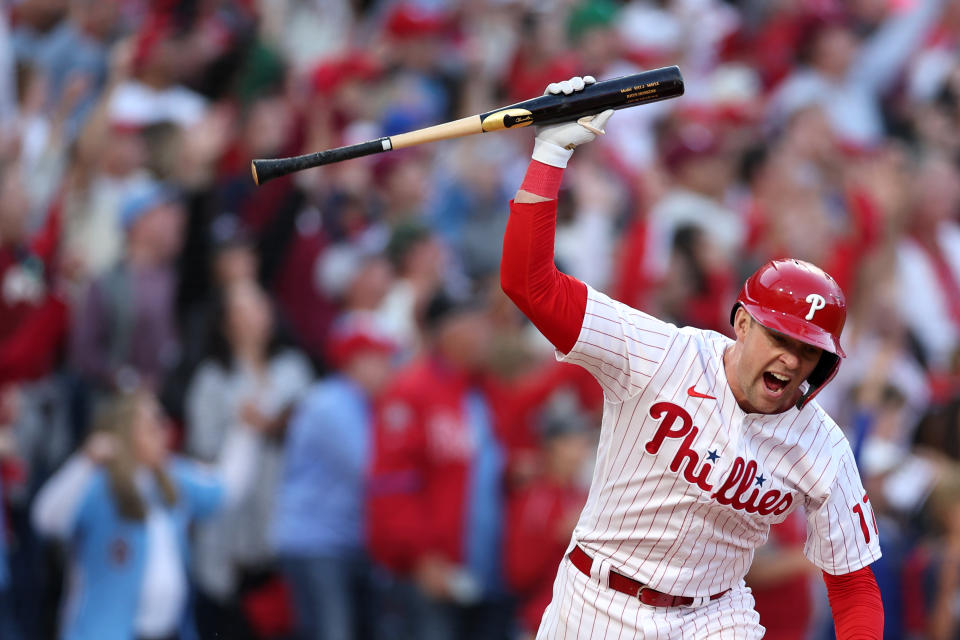Philadelphia is the City of Brotherly Love, but it could also be described as the City of Tough Love. For the past decade, the Phillies have been desperately striving for approval, but earning only exasperation. This being Philly, there was no sugarcoating: The fans were both mad and disappointed — until Friday.
Over the past five seasons or so, with results from a rebuild long overdue, the team had assumed the posture of a family in turmoil gritting its teeth through Thanksgiving dinner. Sometimes, the tension spilled into plain sight.
You know the story by now of how that cloud lifted. Fairly or not, the 2022 club finally hit its long-awaited stride when the Phillies made a change at the head of the table, replacing famously high-strung manager Joe Girardi with the looser stylings of career bench coach Rob Thomson.
The run to claim and cling to a postseason spot was a relief. But Friday’s cathartic return to Citizens Bank Park saw the Phillies drop the baggage of the past decade — nay, spike it — in a 9-1 victory over the Atlanta Braves that tipped the NLDS strongly in their favor.
Hoskins’ emphatic reaction to his tone-setting home run off Braves rookie Spencer Strider spoke to the burden unloaded. For Hoskins, Aaron Nola and Bryce Harper — stars drafted into the struggle and stars who chose it — this was the game that saw the void of unfulfilled expectations supplanted by highlights and deafening roars.
Nola, the longest-tenured Phillie, has been fronting this rotation since 2015. He’s been one of baseball’s most productive starting pitchers, but had never been afforded the chance to strut his stuff under the spotlight of October. Since Nola’s full emergence in 2017, only Gerrit Cole has thrown more innings. Only nine starters have bested his park-adjusted ERA and — in a not-so-subtle nod toward how the Phillies have failed him — only four have bested his park-adjusted FIP, which estimates how well Nola pitched independent of the defense behind him.
Now, he’s making up for lost time. His last three starts have been masterpieces, and significant ones. On Oct. 3, he flirted with a perfect game and ended up throwing 6 2/3 scoreless frames to get the win that clinched a postseason berth. On Saturday, he fired another 6 2/3 scoreless innings to get the win that ended the wild-card series and eliminated the St. Louis Cardinals. And on Friday, he stymied the Braves for 6+ innings — allowing only an unearned run — to win a crucial Game 3 and put the Phillies on the cusp of a trip to the NLCS.


Hoskins debuted in 2017, crushing 18 homers in a blistering 50 games to provide a rare bright spot, along with Nola, on a team that lost 96 games. In the years since, his furious rallies and crushing slumps have made him an avatar of the franchise as a whole — which, as you may have gathered, wasn’t often a good thing.
On one hand, his numbers unmistakably belong to a Good Hitter. He has been at least 11% better than the league average hitter in every season, by park-adjusted OPS. He reliably hits 25+ homers per full season. But his inconsistency — those overall good numbers are often an average of extreme hot and cold streaks — and defensive limitations burned under the microscope of an anxious fan base.
And speaking of under the microscope, there’s Harper. The superstar who devoted the rest of his career to the Phillies prior to 2019 — signing a 13-year, $330 million deal — must have started to worry that he was reliving an unsatisfying progression from his time with the Nationals.
From the beginning, he has made outward efforts to endear himself to Philadelphia. He could wear any bandana under his hat, but he wears the one that looks like the Philly Phanatic’s eyes. Maybe it’s over the top, but it’s effort. He has also been the excellent player that was promised, winning his second MVP award in 2021. He just hadn’t been able to carry his team to glory. It’s an unrealistic expectation for any baseball player — Nola and Hoskins included — but it is an expectation nonetheless, perhaps more so for Harper than for anyone else.
Limited by an elbow injury early in the season, then by a broken thumb late in the season, Harper hadn’t managed to pull a home run since returning from the thumb injury until the wild-card series. On Friday, he demolished one deep into the stands in right-center, evoking some of his most memorable moments in Philadelphia, and adding the multiplying effect of October.
After an uncharacteristic splurge of small ball won them the St. Louis series, this was the Phillies winning with the horses that got them here. Big homers, big aces. Demolishing the Braves in Game 3 doesn’t guarantee they will win the series and advance — far from it — but it brought a blueprint to life.
Grievances, concerns, shortcomings. One by one, the Phillies are discarding them.
The defense that has so often failed them still isn’t great, but it’s manageable. The major investments are stoking wins instead of anxiety. J.T. Realmuto, the trade acquisition Harper fought to keep, scored on his homer. Where Jake Arrieta floundered alongside Nola, Zack Wheeler has stepped in as an equally formidable ace. Nick Castellanos’ stumbles in the regular season have turned into a string of huge hits in the postseason. The bullpen hasn’t come up yet, which is just about the best thing you can say about a bullpen.
Eleven years after Ryan Howard tore his Achilles and the Jimmy Rollins/Chase Utley era came to a crashing halt, Phillies fans have understandably built up some skepticism.
This, the Game 3 performance seemed to say, isn’t another pie-in-the-sky plan doomed to fail. These Phillies have something real to bring to the table, something that may even be worthy of a toast.
